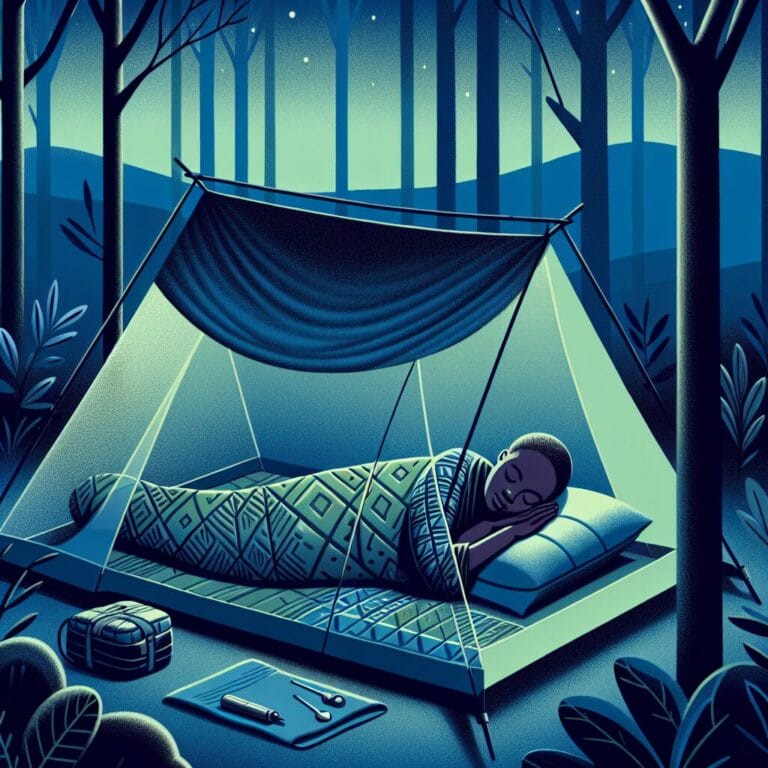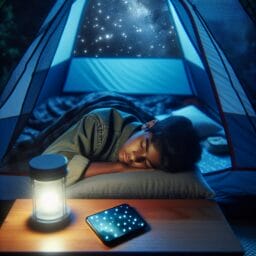
Embracing the Wild: Sleep Optimization Tips for Nature-Loving Adults
Table of Contents
- Introduction
- The Science of Sleep in Nature
- Preparing for Sleep in the Wild
- Sleep-Enhancing Activities in Nature
- Nutrition and Hydration for Better Sleep Outdoors
- Safety and Sleep in the Wilderness
- Overcoming Common Sleep Challenges in Nature
- Technology and Tools for Sleep Tracking
- The Psychological Benefits of Sleeping Outdoors
- Conclusion
- Frequently Asked Questions
Introduction
Hey, did you know your body has a super cool built-in alarm clock? It’s called the circadian rhythm! This nifty body clock helps you feel awake when the sun shines and sleepy when it gets dark. But guess what? Spending too much time indoors with artificial lights can make your body clock go “Huh?” So, here’s a fun fact: getting your daily dose of sunshine by playing outside isn’t just awesome, it actually helps you snooze better at night! That’s right—hanging out under the big blue sky can lead to some seriously good sleep.
Now, let’s talk about reducing stress. It sounds like grown-up talk, but everyone gets stressed sometimes—even kids. You might not believe it, but chilling in nature is like pressing a giant ‘refresh’ button for your brain. When you build forts in the woods or spot fluffy clouds in the park, your worries melt away like ice cream on a hot day. And less stressing means more ZZZs when it’s bedtime!
But hey, don’t just take my word for it. Scientists say that the recommended amount of zzz-time for youngsters is super important for growing up strong and smart! And guess what else? Good sleep habits start with where you snooze! So next time you camp out in the backyard or go on a family hike, think of it as turning your sleep environment into a dreamy outdoor bedroom—with bonus stars and fresh air for extra cozy vibes!
So kiddos (and parents!), remember this: if you want healthy sleep that makes you feel like a superhero every morning, get outside and soak up some natural light. Your body will thank you with some good-quality sleep—a secret power boost from Mother Nature herself!
The Science of Sleep in Nature
Did you ever wonder why a weekend camping trip can leave you feeling so refreshed? It’s like magic, but science has the scoop on it! Picture this: when you’re out in the wild, away from city buzz and screen glares, your body gets a chance to align with nature’s clock. This isn’t just any clock; it’s your circadian rhythm – that uber-smart internal timekeeper that tells your brain when to feel sleepy or alert.
Studies reveal some pretty cool stuff about how our bodies react to time outdoors. For starters, breathing in fresh air and being surrounded by green space can dial down stress levels big-time. This happens because natural environments trigger soothing responses in our brain; imagine them as built-in spa sessions for your mind. Less stress during the day means your head hits the pillow ready for some good-quality sleep—not tossing and turning with worry.
Researchers have also found that folks who soak up natural light during their day tend to have stronger sleep habits. It’s like natural light is a secret ingredient for a night of quality sleep. Why? Well, it helps keep our body clock on schedule, telling our brains “Hey, it’s daytime—stay awake,” and then later, “The sun’s gone down—time to hit the hay!”
But here’s something else we’re finding out: the recommended amount of shut-eye isn’t just about quantity—it’s also about quality. And guess where one of the best places is to get high-quality ZZZs? Yep, right under the stars! Creating a cozy sleep environment outdoors might just be what you need for healthy sleep that’ll power you up for tomorrow’s adventures.
So next time you plan an outdoor excursion, think of it as not just fun (though it totally is), but as investing in your night-time recharge too. Sure beats counting sheep!
Preparing for Sleep in the Wild
Did you know that the right camping gear can turn a night outdoors into an epic sleep adventure? Yep, it’s not just about having a tent and a sleeping bag—these are your basic sleep-saving gadgets for sure, but there’s more to the story. To really kick your outdoor snooze-fest up a notch, let’s talk about sleeping pads and pillows. These nifty inventions aren’t just fluffy extras; they’re like your sidekick in fighting against the hard, bumpy ground. A comfy pad means saying “no thank you” to rocks poking at you all night and “hello” to floating on cloud nine while you gaze at the stars.
Speaking of seasons, ever tried snuggling up in a summer-weight bag during fall? Brrr! Here’s where seasonal smarts come into play. Each season calls for different gear to keep you cozy without turning your tent into a sauna or an igloo. When leaves start doing their colorful dance in fall or when flowers pop out in spring, make sure your sleep setup matches Mother Nature’s mood. This means lighter bags for warm nights and something snug for when Jack Frost comes nipping.
And check this out: quality sleep isn’t only about what’s under and over you; it’s also about what’s around you. Your sleep environment plays superhero in this tale of nighttime restfulness. It should be safe from elements (like unexpected rain showers or nosy bugs) but still let nature’s lullabies (think cricket concerts and rustling leaves) serenade you to slumberland.
So grab that trusty tent, unfurl the sleeping pad, fluff up that pillow just right, choose the best sleeping bag for the weather – and voilà! You’ve got yourself an outdoor bedroom fit for some serious zzz-catching adventures. Whether it’s summertime laughter around the campfire or wintery whispers under snow-laden trees, optimizing these little details means healthy sleep is part of every outdoor escapade—making every wakeup call one filled with anticipation for new journeys!
Sleep-Enhancing Activities in Nature
Picture this: You’ve spent a sun-soaked day hiking through the forest, spotting wildlife and splashing in a crystal-clear lake. Your body, supercharged with sunshine and fresh air, feels alive and buzzing with energy. But as the golden hour fades into a twinkling night sky, that same body now craves rest—a deep, rejuvenating sleep amongst the whispers of nature. This isn’t just any kind of tired; it’s the satisfying weariness that comes from moving your muscles in Mother Nature’s gym.
Yoga by the riverside or relaxation exercises on a mountain peak aren’t just good for cool photos—they’re your secret weapon for tackling sleep outdoors. When you stretch out under an open sky, you’re not just impressing the squirrels; you’re telling your mind and muscles to unwind. As dusk settles in, these calming activities sync up with your circadian rhythm, gently nudging it towards dreamland.
Now let’s set the scene for bedtime after a day full of adventure. An effective evening routine can transform your tent into a cozy cocoon ready for quality sleep. Maybe it’s sharing stories around a softly crackling fire or sipping on warm chamomile tea while listening to crickets serenading you from the shadows—these moments help signal to your body clock that it’s almost time to power down.
And let’s not forget about those extra special touches: like snuggling into your sleeping bag after journaling about today’s escapades or reading by lantern light—quiet but powerful rituals that ease you into slumber. These practices harness the natural calm of your surroundings to enhance healthy sleep habits, ensuring that when morning comes, you awake refreshed and eager for new explorations.
So as stars twinkle above and nocturnal creatures chorus in harmony, remember this unique blend of daytime activity and nighttime tranquility is what fuels an optimally rested self—empowering yet another day vibrant with potential amidst the wild’s unpainted canvas.
Nutrition and Hydration for Better Sleep Outdoors
Have you ever pondered on the munchies that might whisk you off to dreamland under a velvet sky? When camping, it’s not just what’s above but also what’s on your plate that can send you to sleep-ville. Delving into foods known for their snooze-inducing superpowers could be the ultimate game-changer in optimizing sleep in nature. Almonds and cherries aren’t only tasty trail snacks; they’re packed with melatonin, the sleepy-time hormone that tells your body clock it’s time to wind down. Plus, sipping some warm milk by the campfire isn’t just cozy—it has tryptophan, an amino acid that helps bring on those Zzzs.
Now let’s talk water—staying hydrated is like giving your body a high-five! It may sound simple, but guzzling enough H2O keeps every part of you happy, including your sleep habits. Good hydration helps regulate temperature and ensures all bodily functions are smooth sailing through the night. But here’s a pro tip: avoid chugging right before bed or else you’ll be tiptoeing through the woods for late-night bathroom breaks!
And while we love a good marshmallow roast, steering clear of caffeine-laden treats when the sun dips is smart thinking for quality sleep. That means saying ‘see ya later’ to chocolate bars and soda pop once evening rolls around. You see, caffeine is like a rowdy raccoon rummaging through your calm campsite—it can keep you wide-eyed when the moon is high. So swapping those out for caffeine-free goodies means nothing will stand between you and counting constellations instead of sheep.
So there you have it—embracing these nuggets of wisdom transforms any sleeping bag into a slumber sanctuary in the heart of nature. Keep your meals camper-friendly yet sleep-savvy and remember: what goes into your belly at dusk plays a starring role as nighttime lullabies from Mother Nature herself cradle you into serene slumber amidst her wilderness wonderland.
Safety and Sleep in the Wilderness
Venturing into nature’s embrace for a restful night under the stars? Think beyond just a pillow and blanket—wildlife awareness is your secret ingredient for safe slumbers outdoors. Here’s a thought: while cozying up in your sleeping bag, remember you’re sharing the space with nature’s residents. It’s crucial to keep food sealed and at a distance from where you snooze, so curious creatures don’t mistake your tent for a midnight diner.
As dusk settles over your campsite, navigating the terrain might seem daunting; but with a trusty flashlight or headlamp in hand, you can ensure every step is taken with confidence. A well-lit path not only steers you clear of unexpected bumps and dips but also keeps nocturnal wildlife at bay. And hey, why not use this time to spot some cool nighttime critters from afar?
Most importantly, let’s chat emergency prep—it’s like having a superhero toolkit at your side if things get dicey. Before snuggling down, familiarize yourself with local hazards—be it weather changes or terrain quirks. Have an action plan ready and gear within reach (think whistle, map, first-aid kit). It doesn’t hurt to brush up on wayfinding skills either because sometimes GPS signals play hide-and-seek out there.
So there it is: making friends with good sleep in the great outdoors isn’t just about catching Zzzs; it’s about blending preparedness with respect for our wild neighbors. This balancing act ensures that when morning rays kiss the sky, you wake up not just refreshed but also thankful for another safe night in nature’s cradle.
Overcoming Common Sleep Challenges in Nature
Ever cozied up in a tent only to find yourself shivering or sweating buckets instead of snoozing? Managing the wild thermostat can be tricky, but here’s a nifty trick: layered sleeping gear. Think of it as an onion of bedtime bliss—you’ve got layers you can peel off or pile on depending on whether Mother Nature cranks the heat or drops a chill bomb. A breathable base layer (like moisture-wicking pajamas), followed by an insulating middle (think fleece or wool), topped with a weather-appropriate sleeping bag lets you fine-tune your nighttime nest for prime sleep potential.
Now let’s talk about nature’s night sounds—the hoots, rustles, and chirps that can either be music to your ears or a jarring jam session when you’re trying to catch those Zzzs. If critter concerts aren’t your thing, consider earplugs as your go-to snooze accessory. They’ll keep the wild orchestra at bay so you can drift off to dreamland undisturbed. But hey, if you’re more the type who finds that natural symphony soothing, then let those serene sounds serenade you deep into slumber-ville.
But what do we do when our outdoor bedroom is less ‘cozy cabin’ and more ‘comfy chaos’? Here are some strategies to wrestle down those common challenges:
– Pick a spot shielded from wind but still has nice airflow—it helps avoid condensation inside your tent turning it into a rainforest.
– Use a tarp under your tent for an extra defense against surprise puddle formations.
– Keep tiny unwelcome guests (hello bugs!) out by checking that your tent mesh is intact.
See? With a blend of clever prep and embracing nature’s quirks, your next open-air sleepover could leave you waking up feeling like wilderness royalty—recharged and ready to reign over another day of adventures!

Technology and Tools for Sleep Tracking
When you’re bedding down under the stars, did you realize there’s smart tech ready to be your dreamy sleep sidekick? That’s right—wearable sleep trackers! These nifty wrist buddies do more than count steps. They’re like secret agents for snooze, monitoring how much shut-eye you’re scoring and even the quality of your zzz’s. They can tell when you’re in deep slumber or just lightly dozing, giving a heads-up on how to improve sleep routines amidst nature’s wonders.
But hang on, we’ve got another cool tool in our outdoor sleep arsenal—apps designed just for monitoring zzz’s and helping us relax. Picture this: You’ve found the perfect camping spot, now imagine drifting off with an app that plays gentle forest sounds or guides you through calming breathing exercises. These apps are like having a personal sleep coach tucked in your pocket, whispering ‘sweet dreams’ as the crickets chirp along.
Of course, while these gadgets and gizmos are super helpful, it’s key to use them wisely. Let’s maintain that balance between enjoying Mother Nature’s lullabies and keeping our tech habits in check. It’s all about using technology as an assistant rather than letting it take over the show—keeping screens dim and usage limited so that natural light and serene surroundings lead the way to good-quality sleep.
So next time you unfurl your sleeping bag amidst rustling leaves and starlit skies, remember that technology can be part of a healthy sleep recipe—even outdoors. Just tune into nature’s rhythm, strap on your tracker, tap into those relaxation apps as needed, and let technology subtly support your quest for nocturnal bliss among tall trees and mountain breezes.

| Technology Type | Function | Description | Usage Tips |
|---|---|---|---|
| Wearable Sleep Trackers | Sleep Monitoring | Wrist devices that track sleep duration and quality, distinguishing between deep and light sleep stages. | Wear during sleep, ensure device is charged, and review data to improve sleep routines. |
| Sleep Monitoring Apps | Relaxation and Sleep Aid | Mobile applications that play ambient sounds or provide guided breathing exercises to improve sleep. | Use before sleep to relax, limit screen time to avoid blue light exposure. |
The Psychological Benefits of Sleeping Outdoors
Did you hear about the camper who woke up feeling like a million bucks? That’s no tall tale; it’s what can happen when you couple your snooze time with Mother Nature’s serenity! If you’re someone who thrums with new ideas or finds solutions to puzzles in your daydreams, imagine what a night under the stars could do for that brilliant brain of yours. Spending time outdoors isn’t just a boon for our bodies; it cradles our creative spirits and untangles our knottiest problems while we sleep.
Imagine lying back on a soft bed of pine needles, the gentle hum of the forest as your lullaby. Studies have shown that natural light and clean air can kick-start our innovation engines even during slumber, making us more adept at thinking outside the box—literally! It’s like each breath of crisp air infuses us with fresh perspectives, and every hour spent in dreamland stitches together new neural pathways teeming with ingenuity.
Now picture this: after a peaceful night of good-quality sleep amidst nature’s splendor, campers report an undeniable spark—an increased sense of connection not only to their surroundings but also to their innermost selves. From real-life tales of rejuvenated artists finding their muse beside babbling brooks to students acing exams post-camping trip, there’s something almost magical about how quality sleep in great outdoors amplifies mental well-being.
So next adventure into the wild might be more than just fun—it could be fuel for your soul and mind. As you prepare your pack with flashlights and trail mix, don’t forget to leave some space for tranquility and starlight. They’re key ingredients not listed on any map but always found where trees canopy overhead—a place where healthy sleep under open skies nurtures not just bodies but also minds rich with burgeoning thoughts and feelings, ready to greet dawn’s new light brimming with boundless possibilities.
Conclusion
A little-known but super fun fact about our surrounding green buddies—plants and trees—is they are like natural sleep potion makers! When spending time outdoors, we breathe in phytoncides, which are chemicals that plants emit to protect themselves from harm. But here’s the twist: these same chemicals can actually help us humans sleep better too! Phytoncides have the power to lower our anxiety, making it easier for us to chill out and slip into a peaceful slumber. So next time you’re camping among the forest friends or snoozing under a leafy canopy, think of it as getting a free dose of sleepy-time magic straight from Mother Nature’s pharmacy.
To make sure we get that good-quality sleep while exploring the great outdoors, let’s not forget to sync up with our body clock by soaking in plenty of natural light during the day. This helps keep our circadian rhythm happy and on track. And when night falls, creating a cozy sleep environment is key—think comfy sleeping mats and snuggly bags that hug you just right in all seasons. By embracing these nature-powered tips for healthy sleep habits, not only do we wake up feeling superhero-level awesome, but we also give ourselves an energy-filled start for tomorrow’s sunlit adventures! Keep this mind: A night cradled in nature’s arms might just hold the secret to unlocking your best ever snooze sessions!



